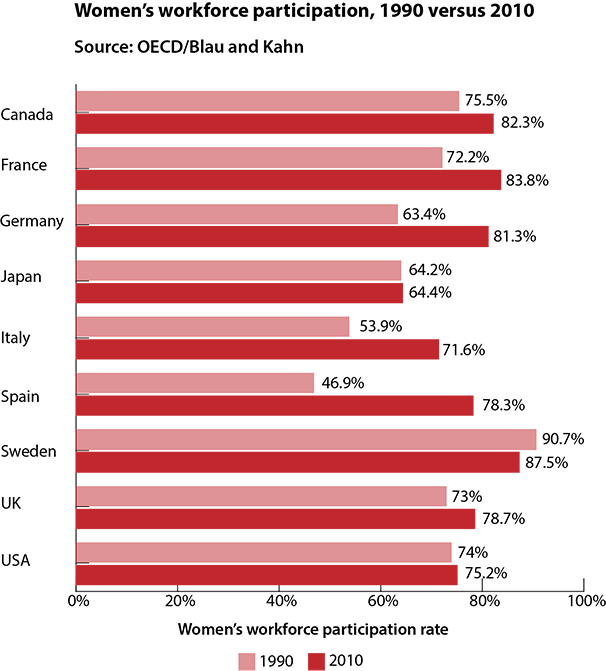A new report released by two Cornell labor professors shows that over the past 20 years, the percentage of U.S. females working has remained relatively stagnant, while many other OECD countries have seen moderate to rapid growth.
In 1990, 74% of American women participated in the workforce. By 2010, that number had risen just over one percentage point, to 75.2%. Contrast that with Canada, France and Germany, which all have female workforce participation at higher than 80%, and other countries like Italy and Spain, which saw double-digit increases. Sweden, which boasts the highest level of female workforce participation at 87.5%, actually dropped three percentage points from its 1990 level.
Admittedly, the numbers don’t tell the whole story. The Washington Post writes that only about 13.1% of American women work part-time, whereas the non-U.S. average is roughly 26%. So when it comes to actual time spent working, U.S. women might not be so far behind their European counterparts.
But the authors also found that a lack of adequate work-life policies, such as mandated parental leave time, can explain about 29% of the decline in American female labor force relative to other countries. Because the U.S. offers almost five times less parental leave time, on average, than European countries, women are often staying away from the workforce. The authors also attribute a lack of public paid leave in the United States to the stagnation of U.S. women joining the workforce, whereas other countries offered paid leave at an average of 38% of wages in 2010.
Ensuring workers have access to paid time off to bond with a newborn and take care of loved ones is essential to keeping families healthy. EOI and the Washington Work and Family Coalition are working to secure dedicated funding for Washington’s yet-to-be funded Family and Medical Leave Insurance system, which would allow workers to take time off to care for seriously ill family members without worrying about lost wages.
It’s not all bad news for women in the U.S., however. The report does note that American women are more successful in rising through the business world than are European women, and they are comparatively more likely to hold “professional” positions. The authors, in the end, conclude that while generous leave policies lead to increased female workforce participation, they can also be associated with increased gender inequities.
By EOI Intern Bill Dow
More To Read
September 24, 2024
Oregon and Washington: Different Tax Codes and Very Different Ballot Fights about Taxes this November
Structural differences in Oregon and Washington’s tax codes create the backdrop for very different conversations about taxes and fairness this fall
September 10, 2024
Big Corporations Merge. Patients Pay The Bill
An old story with predictable results.
September 6, 2024
Tax Loopholes for Big Tech Are Costing Washington Families
Subsidies for big corporations in our tax code come at a cost for college students and their families

